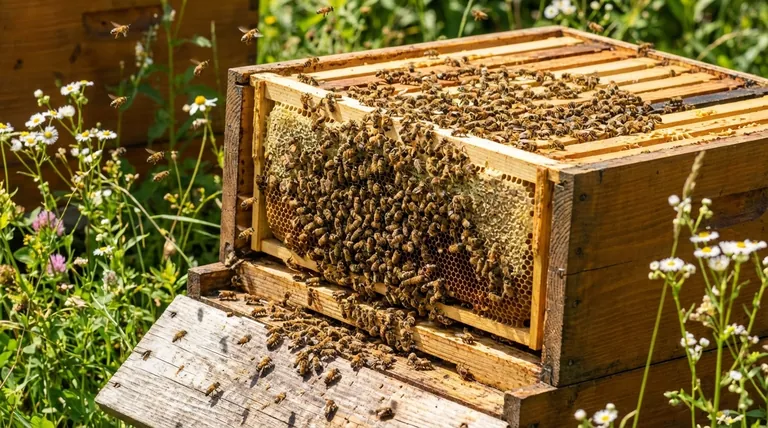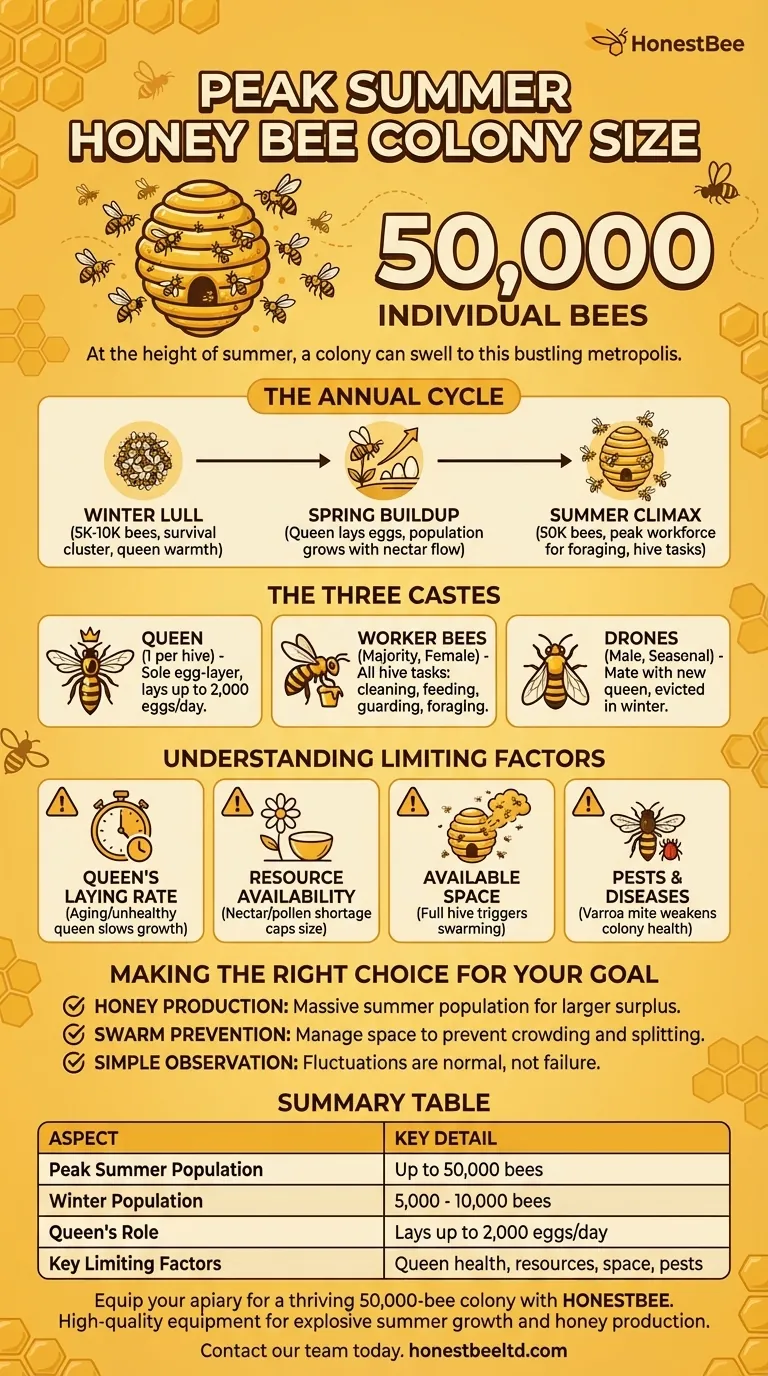At the height of summer, a honey bee colony can swell into a bustling metropolis of staggering size. This peak population typically reaches up to 50,000 individual bees, all working in concert for the survival and prosperity of the hive.
A colony's peak summer population is not a static number but the climax of a meticulously timed annual cycle. This explosive growth is dictated by the queen's ability to lay eggs and the availability of nectar and pollen, directly fueling the colony's workforce and its capacity for survival.

The Annual Cycle: From Winter Cluster to Summer Peak
A colony's population ebbs and flows dramatically with the seasons. Understanding this rhythm is key to understanding the hive.
The Winter Lull
In the cold of winter, the colony shrinks to a core survival group of perhaps 5,000 to 10,000 bees. Their sole purpose is to form a tight cluster around the queen, vibrating their muscles to generate heat and keep her alive until spring.
The Spring Buildup
As days lengthen and the first flowers bloom, the queen begins her most critical work. She starts laying eggs, and the colony's population begins to build rapidly, timed to coincide with the main nectar flows.
Reaching the Summer Climax
The 50,000-bee figure represents the absolute peak, usually reached in early to mid-summer. This massive workforce is almost entirely composed of foragers collecting resources, nurse bees caring for the young, and others performing vital hive tasks.
The Three Castes That Define the Colony
The population number is made up of three distinct types of bees, each with a specialized role.
The Queen: The Colony's Engine
There is only one queen in a healthy colony. She is the sole egg-layer, and her health dictates the hive's potential. A strong queen can lay up to 2,000 eggs per day, single-handedly birthing the entire summer workforce.
The Worker Bees: The Vast Majority
The tens of thousands of bees that make up the bulk of the population are all female worker bees. They are responsible for every task that keeps the colony running, from cleaning the hive and feeding the young to guarding the entrance and foraging for food.
The Drones: A Seasonal Necessity
Male bees, or drones, make up a small fraction of the summer population. Their only purpose is to mate with a new queen. They are produced in the spring and are often evicted from the hive before winter to conserve resources.
Understanding the Limiting Factors
A colony doesn't automatically reach 50,000 bees. Several factors can limit its growth and ultimate size.
The Queen's Laying Rate
The colony cannot grow faster than the queen can lay. An aging, poorly mated, or unhealthy queen will result in a smaller population, as she cannot produce the sheer number of eggs required for explosive growth.
Resource Availability
A population boom requires immense resources. If there is a shortage of nectar and pollen—a period known as a "dearth"—the colony will instinctively slow down brood production to conserve food, capping its potential size.
Available Space
Bees require physical space to raise brood and store honey. If the hive becomes too full—a state called "honey-bound"—the queen runs out of cells to lay eggs in. This is a primary trigger for the colony to swarm, where the old queen leaves with half the bees to find a new home.
Pests and Diseases
Factors like the Varroa mite, a devastating parasite, can severely weaken a colony's health. A hive struggling with a high pest load or disease will divert energy from growth to survival and will likely never reach its peak population potential.
Making the Right Choice for Your Goal
Understanding the dynamics of colony size helps you interpret what you see and manage the hive effectively.
- If your primary focus is honey production: A massive summer population is your goal, as more foragers directly translate to a larger honey surplus.
- If your primary focus is swarm prevention: You must proactively manage hive space, ensuring the queen always has room to lay to prevent the colony from feeling crowded and splitting.
- If your primary focus is simple observation: Realizing that population fluctuates is key; a smaller colony in early spring or late fall is perfectly normal and not a sign of failure.
Ultimately, viewing the hive not as a collection of individual bees but as a single, dynamic superorganism is the key to appreciating its remarkable annual journey.
Summary Table:
| Aspect | Key Detail |
|---|---|
| Peak Summer Population | Up to 50,000 bees |
| Winter Population | 5,000 - 10,000 bees |
| Queen's Role | Lays up to 2,000 eggs/day |
| Key Limiting Factors | Queen's health, resource availability, hive space, pests/diseases |
Equip your apiary for a thriving 50,000-bee colony with HONESTBEE. A strong, populous hive requires reliable, high-quality equipment to support its explosive summer growth and honey production. As a trusted wholesale supplier for commercial apiaries and distributors, we provide the durable beekeeping supplies and infrastructure needed to manage peak populations effectively and maximize your harvest. Let's discuss your specific needs — contact our team today to ensure your operation is built for success.
Visual Guide

Related Products
- HONESTBEE Advanced Ergonomic Stainless Steel Hive Tool for Beekeeping
- Professional Dual-End Stainless Steel Hive Tool for Beekeeping
- Long Langstroth Style Horizontal Top Bar Hive for Wholesale
- Plastic Bee Hive Stand for Beekeeping
- Beehive Handle and Frame Rest Cutting Machine: Your Specialized Hive Machine
People Also Ask
- What is a hive tool and what are its uses? Master Your Hive Inspections with the Essential Beekeeper's Tool
- How is a hive tool used for scraping and cleaning? Master Hive Maintenance for a Healthy Colony
- Why is it important to compare the progress of different hives? A Beekeeper's Key Diagnostic Tool
- Why do hive tools have a hole? Unlock the Secret to Efficient Beekeeping
- What is the hole in a hive tool for? A Multi-Tool for Apiary Repairs and Maintenance



















